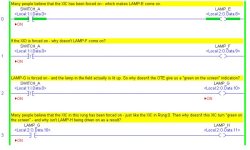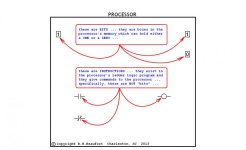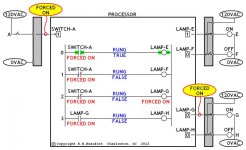(27) on rung 1, the XIO instruction tells the processor to "go look for a zero" in the bit/box for SWITCH-A ... the processor does NOT find a zero – so the processor evaluates the XIO as FALSE ... this results in FALSE logic for the rung ...
(28) don't miss the fact that having SWITCH-A denoted as "FORCED ON" on the computer screen does NOT have the effect of making the XIO instruction either ON – or TRUE ... specifically, once again, the "FORCED ON" legend is merely telling us that the field signal from SWITCH-A is being forced on ... more specifically, the "FORCED ON" legend is NOT telling us that the XIO will be evaluated as "on" or "true" ...
(29) this is very hard for most people to accept ... a frequent question is: "But if I've forced it on, why isn't it true?" ... the reason for their confusion is that the "FORCED ON" legend on the screen does NOT refer to the status of the instruction (the XIO) that they're pointing to ... specifically, the "FORCED ON" legend on the screen ONLY tells us that the field signal from SWITCH-A is being forced on ...
(30) here's another "secret-handshake" ... whenever you Right-Click on any instruction to install a "FORCE" – you are NOT selecting the instruction (the XIC, XIO, OTE, etc.) ... instead ALL that you are doing (I repeat ALL that you are doing) is selecting the ADDRESS associated with the instruction ... by selecting the address (for example: SWITCH-A) you are telling the RSLogix software which FIELD SIGNAL you want to force ...
(31) earlier I pointed out that sometimes people will say: "Force that OTE" or "Force that XIO" ... those statements are misconceptions – they are WRONG – and they are confusing ...
(32) to nail this idea home, consider that it makes ABSOLUTELY NO DIFFERENCE whether the instruction that you Right-Click when forcing happens to be an XIC, an XIO, an OTE, an OTL, or an OTU instruction ... as long as the ADDRESS over the instruction remains the same, you'll get EXACTLY the same results each and every time you force ANY of those various types of instructions ...
(33) here's a "weird" demonstration to prove the point ... you can even force an ONS (One Shot) instruction – as long as you give it a valid INPUT or OUTPUT address ... now the One Shot might not work correctly – but the fact that you can apparently "force" the One Shot is another indication that it's actually the ADDRESS that's being selected by the Right-Click ... specifically, it is NOT the type of instruction that determines either HOW - or WHERE - the force will be applied ...
(34) the "take away" from this part of the discussion is that we NEVER force INSTRUCTIONS ... instead we only force FIELD SIGNALS – either incoming field signals – or outgoing field signals – but NEVER instructions ...
(35) now to finish up with rung 1, when the FALSE rung condition reaches the OTE for LAMP-F, the OTE instruction tells the processor to "go write a zero" into the bit/box for LAMP-F ...
(36) on rung 2, the XIO instruction tells the processor to "go look for a zero" in the bit/box for SWITCH-A ... the processor does NOT find a zero – so the processor evaluates the XIO as FALSE ... this results in FALSE logic for the rung ...
(37) as on rung 1, having SWITCH-A denoted as "FORCED ON" on the computer screen does NOT affect whether the XIO instruction will be evaluated as either TRUE or FALSE ...
(38) continuing right along with rung 2, when the FALSE rung condition reaches the OTE for LAMP-G, the OTE instruction tells the processor to "go write a zero" into the bit/box for LAMP-G ...
(39) do not be misled by the "FORCED ON" legend under the OTE for LAMP-G ... that has NOTHING to do with the fact that the processor will obey its ladder logic program (NOT the force) and will definitely "go write a zero" into the LAMP-G bit/box precisely as the ladder logic dictates ...
(40) and if you're a big fan of "green on the screen" indications, you're about to be sorely disappointed by the display of the OTE for LAMP-G ... notice that even though the FIELD DEVICE (the actual lamp in the field) is being driven ON, the OTE does NOT indicate a "green on the screen" condition ... that's simply because the bit/box contains a status of ZERO - and not a status of ONE ...
(41) this is hard for most people to accept ... a frequent question is: "But if I've forced the lamp on, why isn't it turning on?" ... here the lamp (the device located in the field) actually IS being "turned on" ... but "green on the screen" indications can be misleading because they NEVER relate directly to the status of the field devices ... instead these indications are a result of what status the RSLogix5000 software "sees" in the bit/boxes ...
(42) since the bit/box in this case contains a status of zero, the software is showing the OTE without a "green on the screen" highlight ...
(43) another frequent question is: "But if I've forced the OTE on, why doesn't it go write a ONE into the bit/box?" ... the answer is that the OTE was NOT actually forced in the first place ... instead, the ADDRESS for LAMP-G was selected – and so the force operation was actually applied to the FIELD SIGNAL for LAMP-G ... the field signal is DOWNSTREAM of the bit/box – so the bit/box does NOT change state to reflect the force ...
(44) on rung 3, the XIC instruction tells the processor to "go look for a one" in the bit/box for LAMP-G ... the processor does NOT find a one – so the processor evaluates the XIC as FALSE ... this results in FALSE logic for the rung ...
(45) don't miss the fact that having LAMP-G denoted as "FORCED ON" on the computer screen has NOTHING to do with the TRUE or FALSE status of the XIC ... specifically, the "FORCED ON" legend is merely telling us that the field signal to LAMP-G is being forced on ... more specifically, the "FORCED ON" legend is NOT telling us that the XIC (the instruction) is being forced either "on" - or "true" ...
(46) this is another hard idea for most people to accept ... seeing the XIC marked "FORCED ON" on the screen SEEMS to indicate that the XIC instruction is being forced on – but that is NOT what is happening here ... this is yet another indication that the instructions (XIC, XIO, etc.) in the ladder logic are NOT being "forced" ...
(47) and to finish up with rung 3, when the FALSE rung condition reaches the OTE for LAMP-H, the OTE instruction tells the processor to "go write a zero" into the bit/box for LAMP-H ...










